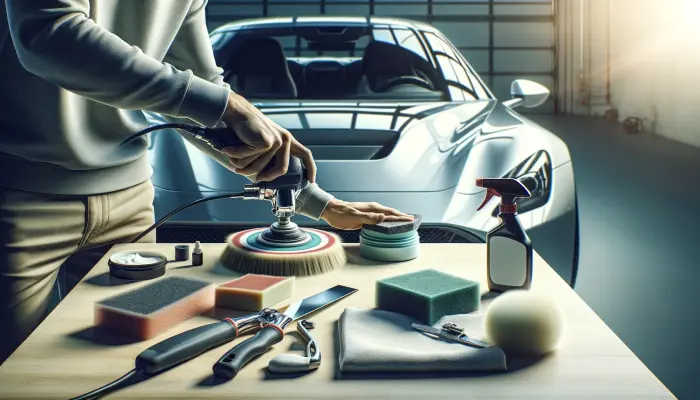The most common reasons for scratches on a car windshield include:
- The impact of hard particles of dust and dirt, especially when they get stuck under the windshield wipers, causing each movement of the wipers to leave scratches.
- The impact of small stones, a common issue for cars frequently traveling on unpaved or gravel roads. Even a tiny stone flying from under the wheels of the car ahead at high speed can leave a noticeable scratch or chip.
- Neglecting car maintenance rules. For instance, using overly rough abrasive materials, metal scrapers, or brushes with hard bristles for cleaning the glass can necessitate polishing.
Polish or Replace?
Polishing the windshield is a more economically viable option compared to replacing the glass, especially if it's equipped with additional features like rain sensors or heating elements. However, polishing is not always effective. Experts recommend using it in cases like:
- A small number of scratches located in one area, with a depth not exceeding 300 microns.
- High cost of a new windshield, particularly if it's equipped with additional features.
- The desire to preserve the car's original equipment for future resale.
Before starting the polishing process, assess the depth of the scratches. If your fingernail catches on the scratch, it's better to replace the glass, as polishing won't eliminate such a defect. Also, consider replacing the glass if it has many scratches or if the cost of a new windshield is not high.
Necessary Tools and Materials
Before you begin polishing the windshield, prepare the following tools and materials:
- A polishing machine capable of adjusting speeds from 1200 to 1700 revolutions per minute. Working at higher speeds can overheat the glass and cause cracks.
- A felt wheel for the polishing machine.
- Polishing compounds of varying abrasiveness.
- A marker to indicate problem areas.
- Painter's tape to protect surrounding areas of the glass.
- A spray bottle for water to wash away excess polish and cool the treated surface.
- A glass cleaning agent in spray form.
- A microfiber cloth.
Preparing the Car for Polishing
Before you start polishing the windshield, you need to do some preparatory work:
- Thoroughly wash the glass, degrease it, and dry it.
- Tape off the surrounding areas with painter's tape to avoid accidental damage.
- Mark all scratches and defects that need polishing with a marker.
The Polishing Process
The process of polishing the windshield is as follows:
- Apply the polish to the felt pad of the polishing machine and distribute it over the glass surface. Don't use too much polish at once – you can always add more if needed.
- The polishing should be done without strong pressure, starting at low speeds and gradually increasing. Remember that the polish dries quickly, so periodically moisten it with water.
- Continue polishing until the glass surface visually improves and the scratches disappear.
How to Polish Out Deep
Scratches on the Windshield? If the depth of the scratches on the glass does not exceed 300 microns, you can use the above-described algorithm. In the case of deeper defects, it is recommended to replace the glass. The reason is that prolonged polishing can change the thickness of the glass, impair its optical properties, and lead to distortions, reducing visibility and driving safety. While it might be justified to remove serious scratches from side windows, it is not advisable on the windshield due to the risks involved.
What Can Be Used for Polishing the Glass?
The best option is to purchase a specialized windshield polishing kit, containing compounds based on boron carbide or cerium oxide. These substances have moderate abrasive properties, ensuring a gentle yet effective action. You can also use GOI paste, opting for "GOI-1" as the least abrasive and aggressive version.
It is advisable to avoid using makeshift means like whitening toothpaste and powders, as they can lead to the opposite effect: old scratches may not disappear, and new ones might appear.
Windshield Polishing with Baking Soda
Baking soda mixed with water to a paste-like consistency can be used as an alternative means for polishing the windshield. However, keep in mind that soda is only effective against minor scratches and scuffs, and the process can be very time-consuming due to its minimal abrasive effect.
DIY Windshield Polishing
DIY polishing of the windshield with cerium oxide or other specialized compounds is possible, but several conditions should be met:
- Work in a warm and, importantly, clean environment. Dust on the polished surface is unacceptable, as even a single grain of sand can cause a new, often very deep, scratch.
- Instead of a polishing machine, you can use a grinder, drill, or screwdriver with an adapter, provided they allow speed adjustments in the specified range and can work at low speeds.
- Thorough preparation and the correct choice of polishing compound are key to success. All adjacent vulnerable areas should be protected with tape or film.
Cost of Professional Windshield Polishing
The cost of professional windshield polishing in a specialized service center depends on various factors, including the pricing policy of the specific organization, the severity of the damage, the car model, and the type of installed glass. Expenses can range from 2-3 thousand rubles to 5-6 thousand.
How to Protect the Glass from Scratches?
To avoid the need for polishing the windshield due to wiper scratches, it's important to change them as their elasticity decreases, maintain cleanliness, and not use them on a dry surface. When removing ice and snow, avoid using metal scrapers, preferring polymer tools and applying de-icing liquids.
Useful Tips
After polishing, it is recommended to apply a rain-repellent product to the glass to prevent new scratches. Following basic glass care rules and using quality tools will avoid frequent polishing and removing superficial scratches.
